Metronidazole is a versatile antibiotic and antiprotozoal medication often prescribed for cats experiencing various health issues, from diarrhea to more complex conditions like inflammatory bowel disease. Understanding how metronidazole can help your cat is crucial for effective treatment. This medication works by fighting certain bacteria and parasites, making it a valuable tool in veterinary medicine.
Metronidazole can be highly effective, but you need to be aware of proper dosage and possible side effects.
Administering the correct amount can make a significant difference in your cat’s recovery process and overall well-being.
Knowing how to watch for adverse reactions and understanding its interactions with other medications is equally essential.
While metronidazole can be highly effective, it’s important to be aware of proper dosage and possible side effects.
Administering the correct amount can make a significant difference in your cat’s recovery process and overall well-being.
Knowing how to watch for adverse reactions and understanding its interactions with other medications is equally essential.
What Is Metronidazole?
Metronidazole is an important medication used in veterinary medicine.
It acts as both an antibiotic and an antiprotozoal agent, helping treat a range of infections in cats.
Understanding its chemical nature, purpose, and common brands can help you be more informed about its use for your pet.
Chemical Nature and Purpose
Metronidazole belongs to a class of medications known as nitroimidazoles.
This means it works by disrupting the DNA of bacteria and certain parasites, ultimately inhibiting their growth.
Its broad-spectrum action makes it effective against anaerobic bacteria and protozoa, notably Giardia.
In cats, metronidazole is primarily prescribed for gastrointestinal issues, such as diarrhea and inflammatory bowel disease.
It can help deal with infections that are difficult to treat with other antibiotics.
Given its capabilities, it’s often a go-to medication when veterinarians suspect specific bacterial or parasitic infections.
Common Brands and Forms
You’ll find metronidazole available under several brand names, including Flagyl, Metrogel, and Protostat.
These brands might come in various forms, such as tablets, topical gels, or even liquid formulations.
When administered, dosages are typically based on your cat’s weight.
For example, a standard dose for diarrhea might be 7.5 mg to 10 mg per kilogram of body weight.
Always consult your veterinarian for the correct dosage and formulation suitable for your feline companion to ensure safe and effective treatment.
Benefits of Metronidazole in Feline Medicine
Metronidazole offers several advantages in feline medicine, primarily related to its effectiveness against infections and its anti-inflammatory properties.
It addresses a range of conditions affecting cats, providing relief from troublesome symptoms and promoting better health.
Treating Infections
Metronidazole is commonly prescribed to treat various infections in cats, especially those caused by bacteria and parasites.
It is effective against anaerobic bacteria, which thrive in low-oxygen environments and can lead to serious health issues.
This medication also targets protozoal infections like Giardia, a common cause of diarrhea in cats.
The antibacterial and antimicrobial properties of metronidazole help clear these infections, restoring your cat’s health.
A typical dosage for infections is usually calculated based on your cat’s weight and can vary.
It’s vital to follow your veterinarian’s instructions closely to ensure effective treatment while minimizing potential side effects.
Anti-inflammatory Uses
In addition to treating infections, metronidazole possesses significant anti-inflammatory effects.
It’s often used in managing inflammatory bowel disease (IBD) in cats.
This condition can cause severe gastrointestinal discomfort, leading to symptoms like diarrhea, vomiting, and weight loss.
By reducing inflammation, metronidazole helps improve your cat’s overall digestive function.
This medication aids in controlling the symptoms associated with IBD, allowing for a better quality of life.
It can also be beneficial for dental conditions due to its ability to penetrate bone, promoting healing in periodontal disease cases.
Dosage and Administration

When it comes to administering metronidazole to your cat, it’s crucial to get both the dosage and method correct.
This medication can effectively treat various infections, but following your veterinarian’s guidance is key.
Determining the Right Dosage
The dosage of metronidazole for cats typically depends on their weight and the condition being treated.
Commonly, for diarrhea, the recommended dose is 7.5 mg to 10 mg per kilogram of body weight given twice daily.
If treating a Giardia infection, the dosage increases to 10 mg to 25 mg per kilogram, also administered twice daily for five days.
Always ensure you weigh your cat accurately to calculate the correct dosage.
Using a digital scale can help, and when in doubt, consult your vet for precise dosing recommendations.
Methods of Administration
Metronidazole comes in several forms, including tablets, capsules, and liquid medication.
Tablets and capsules can be given directly or disguised in food.
If your cat is resistant, consider breaking the tablet into smaller pieces or using a pill pocket.
For liquid formulations, use a syringe (without the needle) to administer the correct dose directly into the cat’s mouth.
Make sure to hold the head slightly elevated to encourage swallowing.
Always check with your vet to ensure you are using the right form and method for your cat.
Administering the medication the right way can make the treatment process smoother for both you and your feline friend.
Possible Side Effects and Complications
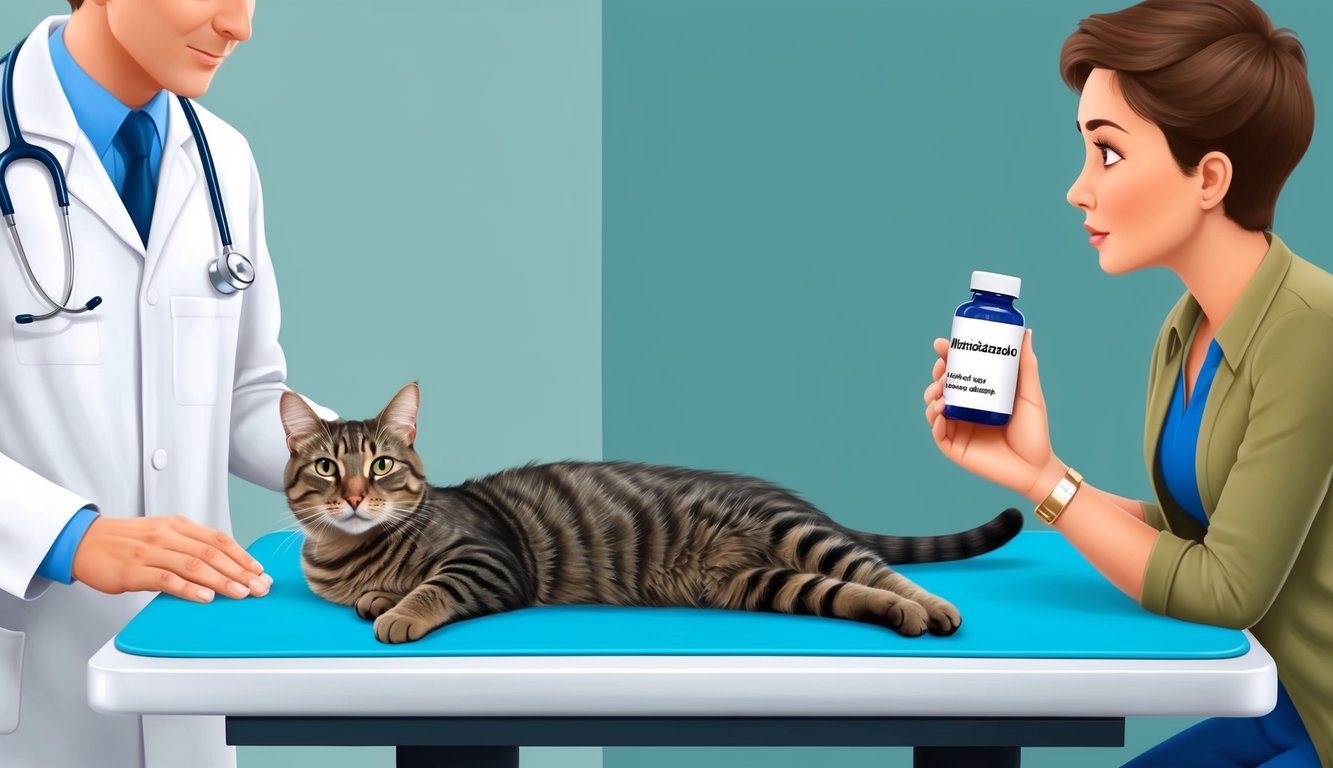
When using metronidazole in cats, it’s important to be aware of potential side effects.
Understanding these risks can help you monitor your pet effectively and seek veterinary care if necessary.
Gastrointestinal Side Effects
Gastrointestinal issues are among the most common side effects of metronidazole.
You might notice your cat experiencing vomiting, diarrhea, or nausea.
These symptoms can arise from the medication’s bitter taste, leading to excessive salivation or drooling.
Increased inappetence may occur, which is a concern since a lack of food can lead to serious complications like hepatic lipidosis.
If you observe any drastic changes in your cat’s eating habits or bowel movements, consult your veterinarian promptly.
Many cats tolerate the medication well, but staying vigilant is key.
Neurological Side Effects
Neurological side effects are less common but can be severe.
Some cats may experience behavior changes or signs of neurological toxicity such as seizures or tremors.
These symptoms are more likely to occur if your cat is on a high dose of metronidazole or has had an accidental overdose.
If you notice any unusual behavior, such as apparent confusion or loss of coordination, it is crucial to contact your vet promptly for advice.
Monitoring your pet closely while on this medication can help catch any potential complications early.
Allergic Reactions and Liver Concerns
Allergic reactions to metronidazole can manifest as skin irritation or cutaneous vasculitis, leading to hair loss, bruising, swelling, or rash.
If you see any signs of unusual skin issues, it could indicate an adverse reaction to the medication.
Additionally, be aware of liver concerns.
Metronidazole can cause liver toxicity in some cats, particularly those with pre-existing liver conditions.
If your cat displays signs such as lethargy, jaundice, or changes in appetite, consult your veterinarian immediately.
Regular check-ups may be recommended to monitor liver function while your cat is on metronidazole.
Drug Interactions and Contraindications
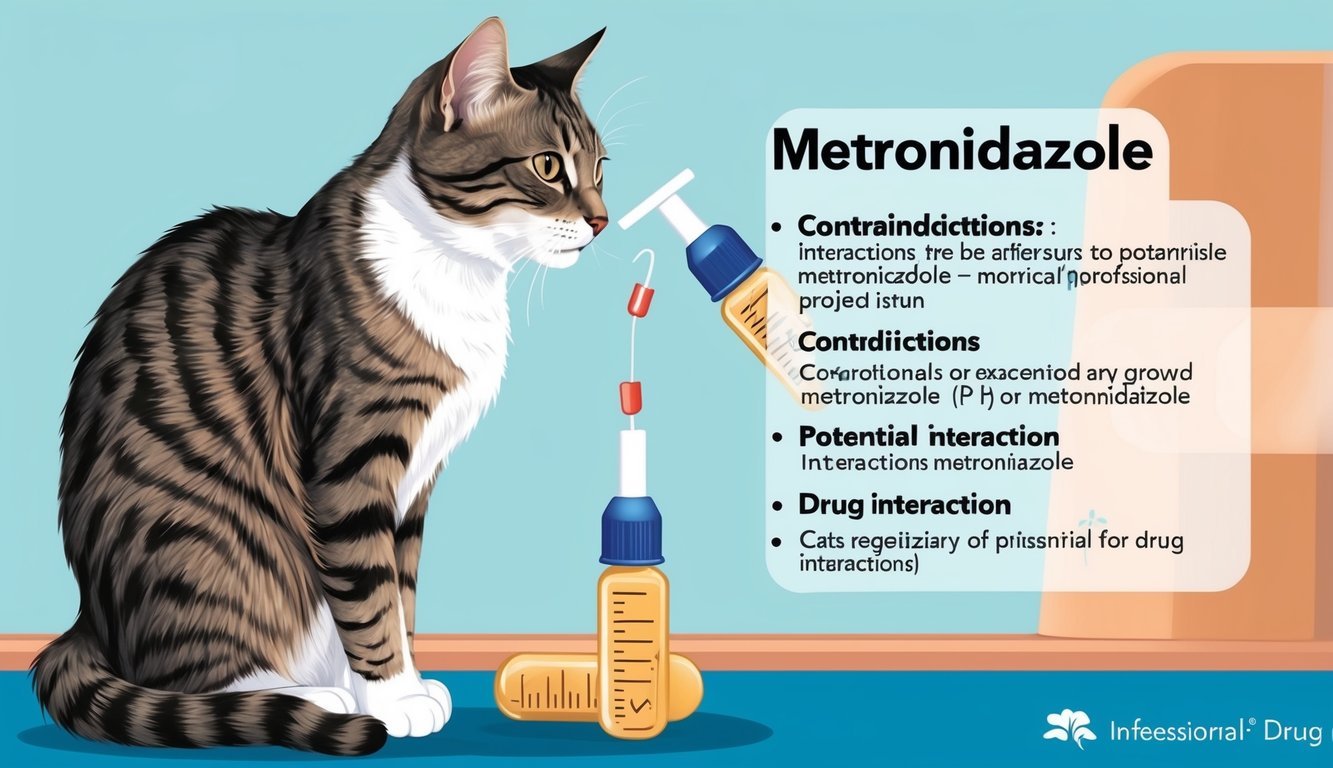
When using metronidazole for cats, it’s essential to understand potential drug interactions and situations where you should avoid its use.
Being informed can help you ensure your cat’s safety and well-being.
Common Drug Interactions
Metronidazole can interact with several medications, which may increase the risk of side effects or reduce effectiveness.
Key interactions include:
- Warfarin: This anticoagulant’s effect may be heightened, increasing bleeding risk.
- Fenbendazole: Combining these could heighten side effects without added benefits.
- Phenytoin: Metronidazole can reduce phenytoin levels, potentially leading to seizures.
- Cimetidine: This medication can increase metronidazole levels, raising the risk of toxicity.
- Lithium: Take caution as metronidazole may increase lithium levels, risking toxicity.
- Cyclosporine: Using both can heighten the risk of absorption issues.
- Phenobarbital: This combination could lead to compromised effectiveness of phenobarbital.
Always consult your veterinarian before starting metronidazole with these medications to manage risks effectively.
When to Avoid Metronidazole
Certain conditions and situations warrant avoiding metronidazole altogether.
First, avoid it in cats with known hypersensitivity to the drug.
Additionally, consider these factors:
- Neurological Disorders: If your cat has a history of seizures or neurological issues, metronidazole might exacerbate these conditions.
- Pregnancy: The drug is not recommended during pregnancy due to potential risks to developing kittens.
- Antibiotic Resistance: Prolonged use can contribute to antibiotic resistance. If an infection can be treated with another antibiotic that poses less risk, that may be the preferred choice.
Always discuss your cat’s health history with your veterinarian to determine the suitability of metronidazole in their treatment plan.
Special Considerations for Cats
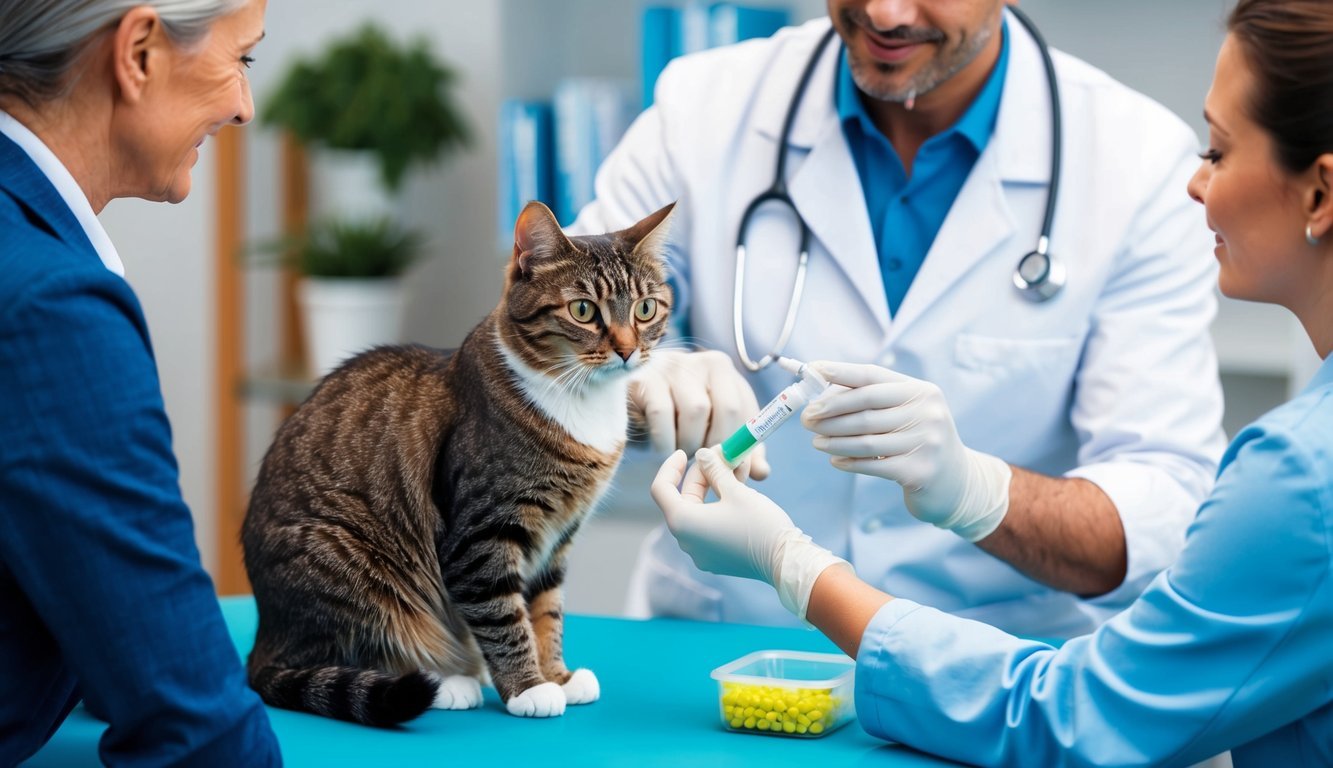
When considering metronidazole for your cat, there are important factors you should take into account.
Special conditions, such as chronic illnesses, can influence how this medication is used and its effectiveness in treating specific health issues.
Chronic Conditions and Metronidazole Use
Cats with chronic conditions, such as inflammatory bowel disease (IBD) or hepatic encephalopathy, may require careful monitoring when prescribed metronidazole.
This antibiotic can disrupt gut bacteria, which is crucial for overall digestive health.
If your cat suffers from IBD, metronidazole can help manage flare-ups by addressing underlying infections.
For cats with liver issues, the drug’s metabolism may be affected, so dosages often need adjustment to prevent toxicity.
Always consult your veterinarian about how metronidazole may interact with your cat’s existing medications or conditions.
Metronidazole Benzoate for Feline Use
Metronidazole benzoate is a specific formulation designed for feline administration.
It offers the same antibacterial and antiparasitic properties as the regular metronidazole but is often preferred for its improved palatability and effectiveness in cats.
When treating conditions like giardiasis, this formulation can be more manageable for finicky eaters.
It allows for easier dosing and may reduce the incidence of side effects such as nausea or salivation.
Your veterinarian can provide guidance on the appropriate dosage based on your cat’s weight and health status, ensuring a safer and more effective treatment plan.
Recognizing and Treating Overuse or Emergency Situations
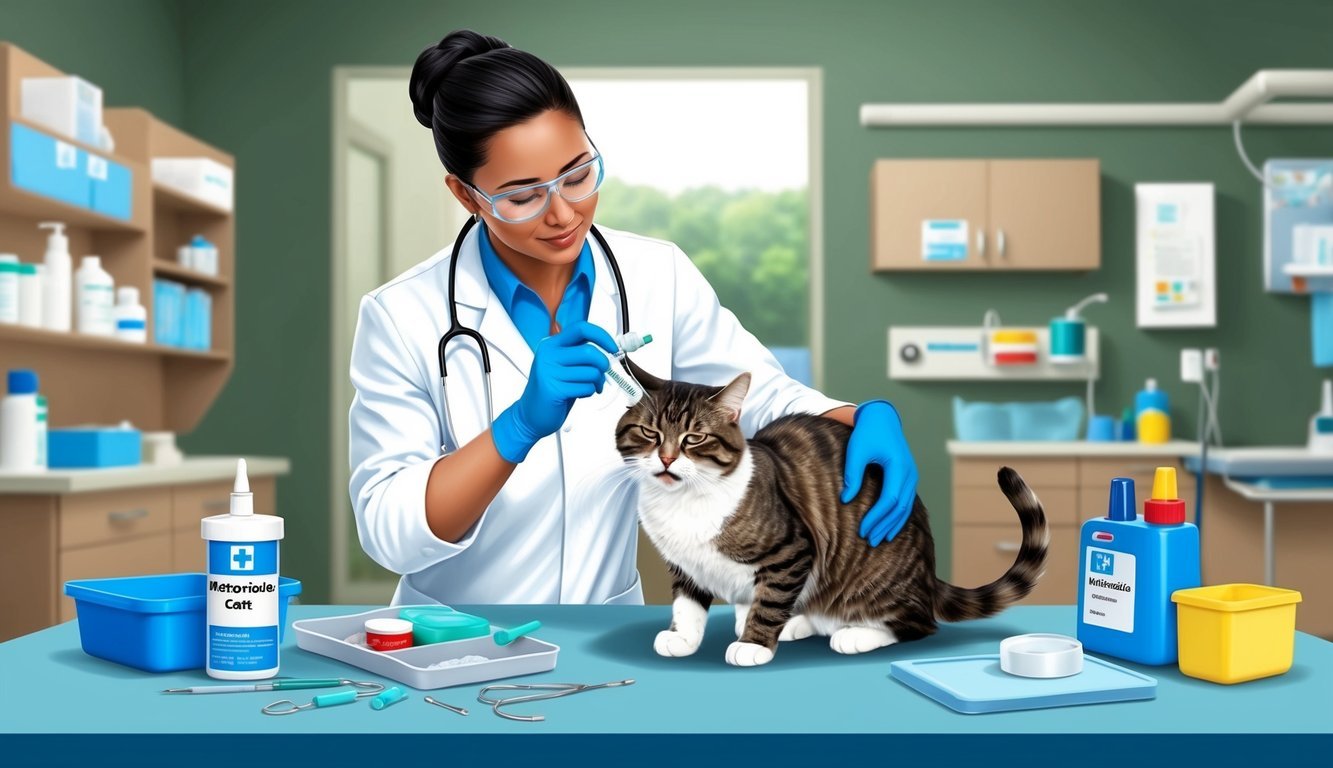
Being aware of potential overuse symptoms and knowing what steps to take in an emergency can be critical when your cat is on metronidazole.
Recognizing these signs early can help you prevent more serious health issues.
Symptoms of Overdose
If your cat has ingested too much metronidazole, several clinical signs can indicate an overdose.
Common symptoms may include:
- Vomiting: Frequent episodes could signal a serious reaction.
- Regurgitation: This is different from vomiting and can indicate gastrointestinal distress.
- Stomach upset: You might notice signs of discomfort or pain in your cat’s abdomen.
Other potential signs include lethargy, loss of coordination, and seizures.
If you observe any of these symptoms, it’s essential to take them seriously.
Immediate Steps and Veterinary Interventions
If you suspect an overdose, your first step is to contact your veterinarian immediately.
While waiting for guidance, keep your cat calm and minimize stress, which can worsen symptoms.
Your vet may recommend bringing your cat in for an examination.
They could conduct tests, monitor vital signs, and possibly administer activated charcoal to limit further absorption of the drug.
In more severe cases, intravenous fluids or medications may be necessary to stabilize your cat’s condition.
Always adhere to prescribed dosages and report any unusual behavior or symptoms to your vet.
Additional Therapeutic Uses
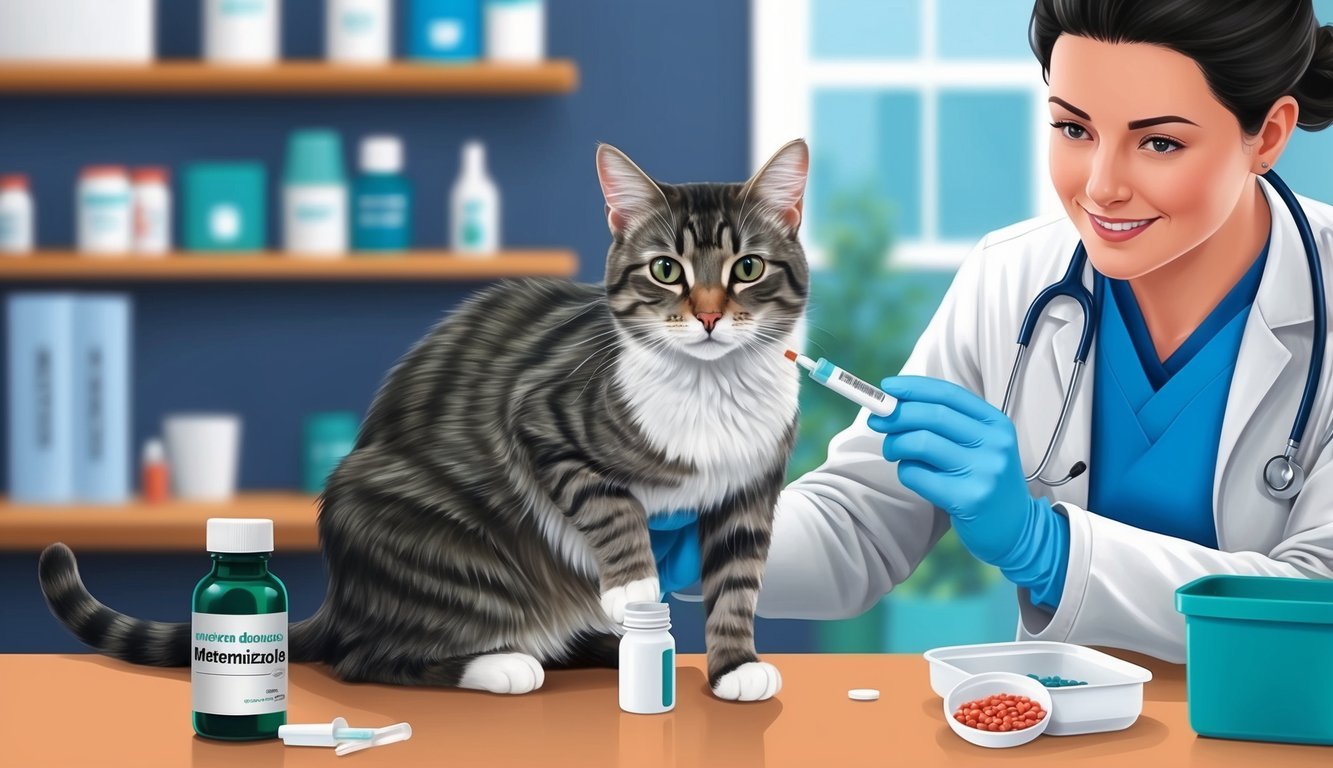
Metronidazole has several therapeutic applications beyond its primary role in treating bacterial and parasitic infections.
Its usage can significantly impact various health issues in cats, particularly gastrointestinal disorders and certain dental problems.
Metronidazole in Combination Therapies
You may find metronidazole effective in combination therapies, especially for conditions like colitis and Clostridium infections.
When used alongside other medications, it can enhance treatment effectiveness.
For instance, it may help alleviate inflammation in the intestines or support bacterial control.
If your cat has chronic gastrointestinal issues, metronidazole can serve as an adjunct treatment, potentially addressing lower appetite due to discomfort.
Always consult your veterinarian to create the best treatment plan that combines metronidazole with other therapies specific to your cat’s needs.
Beyond Gastrointestinal Issues
Metronidazole is not just for gut health; it also plays a role in treating periodontal disease.
The medication can help combat oral infections linked to bacteria, promoting better dental health.
Additionally, it’s effective against parasites like Giardia and Trichomonas.
If your cat is experiencing symptoms such as diarrhea or vomiting due to these parasites, metronidazole can help clear the infection.
It works by disrupting the DNA of these pathogens, making it difficult for them to survive in your pet’s system.
Always ensure you discuss the specific needs of your cat with your vet to determine if metronidazole is appropriate for these situations.
Frequently Asked Questions
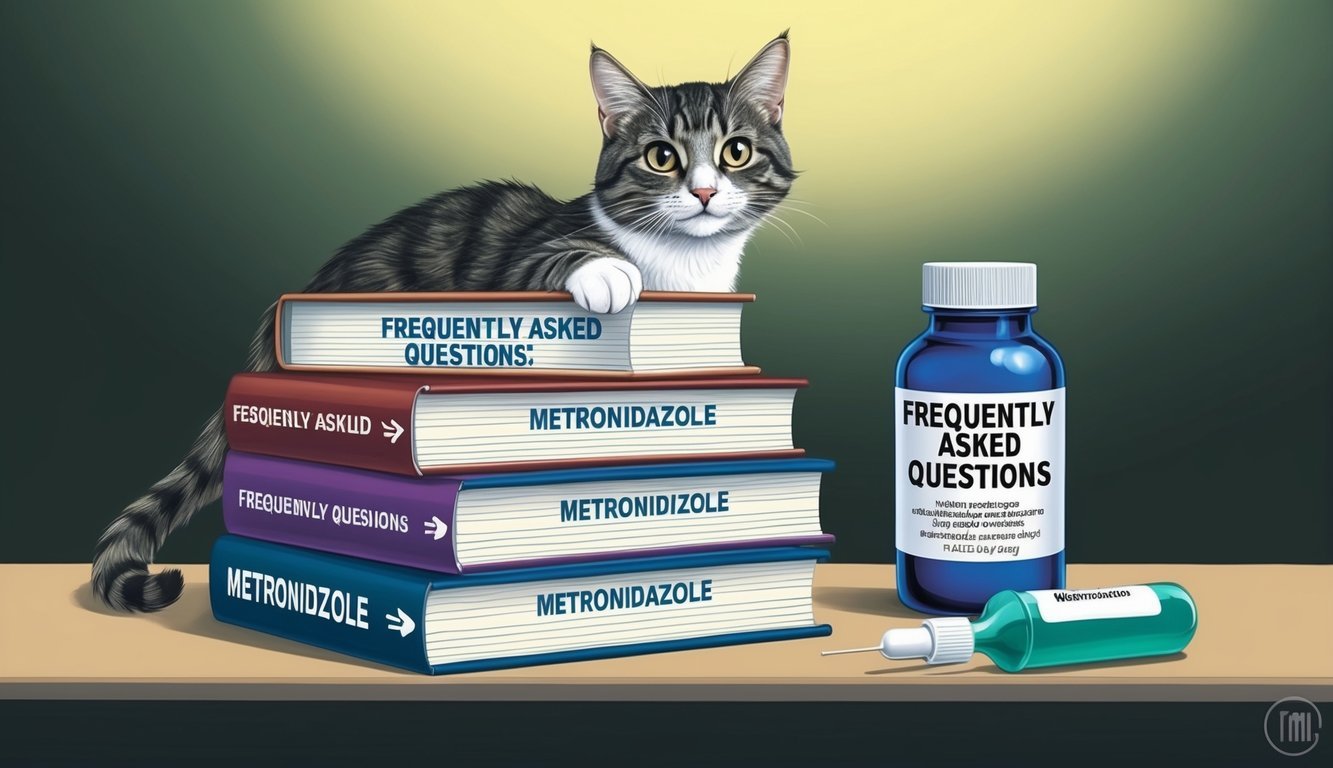
When considering metronidazole for your cat, you might have several common concerns.
This section addresses typical dosages, potential side effects, administration tips, and other important aspects to keep your feline friend safe and healthy.
What’s the typical dosage of metronidazole for a cat?
For an average-sized cat, the common dosage is about one-quarter of a 250-milligram tablet.
More specifically, your veterinarian may recommend a range from 10 to 25 milligrams per kilogram of your cat’s body weight every 12 hours.
If your cat is being treated for Giardia, the dosage may increase to 25 milligrams per kilogram.
What are the common side effects when giving cats metronidazole?
While metronidazole is generally safe, some cats may experience side effects.
These can include nausea, vomiting, loss of appetite, diarrhea, or temporary behavioral changes.
It’s essential to monitor your cat’s reaction and consult your veterinarian if you notice any adverse effects.
How should metronidazole be administered to cats?
Metronidazole can be given in various forms, including tablets or liquid formulations.
You can administer the medication directly into your cat’s mouth or mix it with food.
Always follow your veterinarian’s instructions for the best results.
How quickly does metronidazole begin working in felines?
Metronidazole usually starts to take effect within a few hours after administration.
However, full benefits may take a couple of days, depending on the condition being treated.
It’s important to complete the entire course as prescribed.
Is it okay to give my cat metronidazole on an empty stomach?
You can give metronidazole to your cat on an empty stomach, but it may cause less stomach upset when given with food.
If your cat shows signs of gastrointestinal discomfort, consider administering it with food to help ease those issues.
Can metronidazole be mixed into my cat’s wet food safely?
Yes, you can mix metronidazole into your cat’s wet food.
This can make it easier for your cat to take the medication.
Ensure that your cat consumes the entire portion to receive the full dose.

